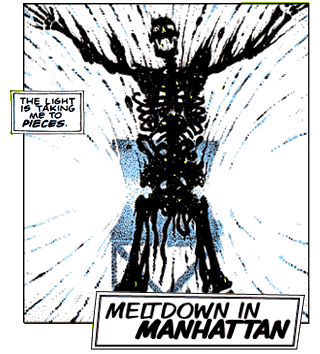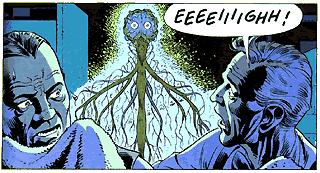
Think the Japanese and South Korean nuclear accidents can't happen in America? Guess what -- they did. Fifty years ago, a Tennessee town was barely saved from destruction, and American doctors watched with clinical detachment as a Canadian scientist had his body turn to simple protoplasm.
Recently, at the uranium-processing plant in Tokaimura, Japan, workers brought together a supercritical amount of uranium solution and started a nuclear chain reaction. According to a spokesperson from the Sumitomo Metal Mining Co., which owns the plant, the workers had been well-trained but had apparently not followed the extensive specifications they had been given on the proper handling of uranium. Though this sounds like typical zaibatsu-speak, that's pretty much how it happened in Oak Ridge, Tennessee.
Pure uranium did not exist in any major quantity on Earth until 1943, when the Manhattan Project first started to refine it on an industrial scale at their Oak Ridge plant. Project scientists knew the plum-colored metal was dangerous, and they were assisted in their handling of it by their knowledge of atomic theory. But in some cases, they didn't know the specifics of how uranium behaved until it was too late.
Richard Feynman, a theorist at the project headquarters in New Mexico, was sent to the Oak Ridge plant with instructions to "make it safe." He found a nuclear explosion waiting to happen. Army officers were storing bottles of uranium nitrate solution side by side in warehouses. Having been told that it would take 20 kilograms of uranium metal (the so-called "critical mass") to start a chain reaction, and knowing that there would never be 20 kilograms of uranium at the plant, the army officers thought they were being prudent. They hadn't been told that atom-splitting is much more effective in water, and that it takes considerably less than 20 kilograms of uranium solution to make a chain reaction. Feynman managed to put a stop to this practice a few hours before Tennessee was turned into the Forbidden Zone.
In those days, the amount of uranium necessary to start a chain reaction had been estimated theoretically, but could only be precisely determined through experimentation. Louis Slotkin, a Manhattan Project experimenter from Canada, took the task upon himself. He tinkered with two hemispheres of uranium, each less than critical mass, using screwdrivers to slide them back and forth across a rod. He watched the dial of a neutron counter, which told him when he was getting close to a chain reaction. The experiment was a screw-up waiting to happen.

No two histories agree on the exact date of the accident, but one day Slotkin's screwdriver slipped. The hemispheres came too close, and a chain reaction started inside the laboratory. Neutrons in the mass of uranium sprang out, smashing into other atoms, releasing tremendous amounts of energy. The lab was filled with the electric blue glare of Cerenkov radiation, as gamma rays slammed into air molecules, causing them to glow. The temperature rose several degrees in a fraction of a second. Radiation saturated everything in the room. Slotkin used his bare hand to pull the hemispheres apart, saving the lab and the town while forfeiting his own life.
He was hospitalized instantly, but it was too late. The hydrogen atoms in his body had taken the brunt of the radiation. Within an hour, Slotkin had lost his sense of touch. Gamma rays had penetrated his skin, and had destroyed his sensitive nerve cells first. This was an unexpected gift, because it spared Slotkin the horror of being conscious of his own death -- by the end of the day he had become delirious.
Slotkin became the Manhattan Project doctors' index case for death by radiation poisoning. Realizing there was nothing they could do to save him, the doctors began to carefully record the destruction of Slotkin's body. By a quirk of fate (or perhaps not), Soviet mole Klaus Fuchs was assigned to study the incident and ascertain what, if anything, could be learned from it.
By measuring the size of the uranium hemispheres in terms of where Slotkin had been standing, it was possible to estimate how much radiation he had received. Over the nine days it took Slotkin to die, his hair fell out and the number of white corpuscles in his blood skyrocketed. His skin, both internally and externally, started coming off in layers. To put it simply, his cells lost their differences -- before long, there was no way to distinguish a liver cell from an intestinal cell from a blood cell. When he died, it was determined that the muscles of his heart were nothing but a mass of torn fibers.
For Slotkin, it was all over, but his unintentional self-destruction established the guidelines for handling uranium. The US, of course, went on to the further adventures at Three Mile Island, and whatever the Soviets made of the affair, it didn't prevent Chernobyl. So it's good that the world still has a store of intrepid nuclear pioneers. With luck, we can rely on Korea and Japan for more experimental data -- instead of doing it ourselves.
Patrick Di Justo stays awake at nights dreaming of Nobel Prizes he'll never win.
